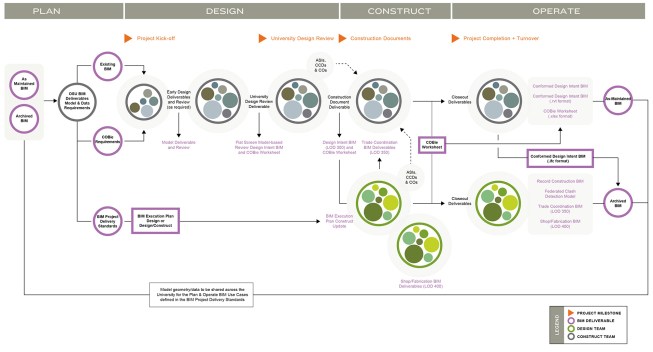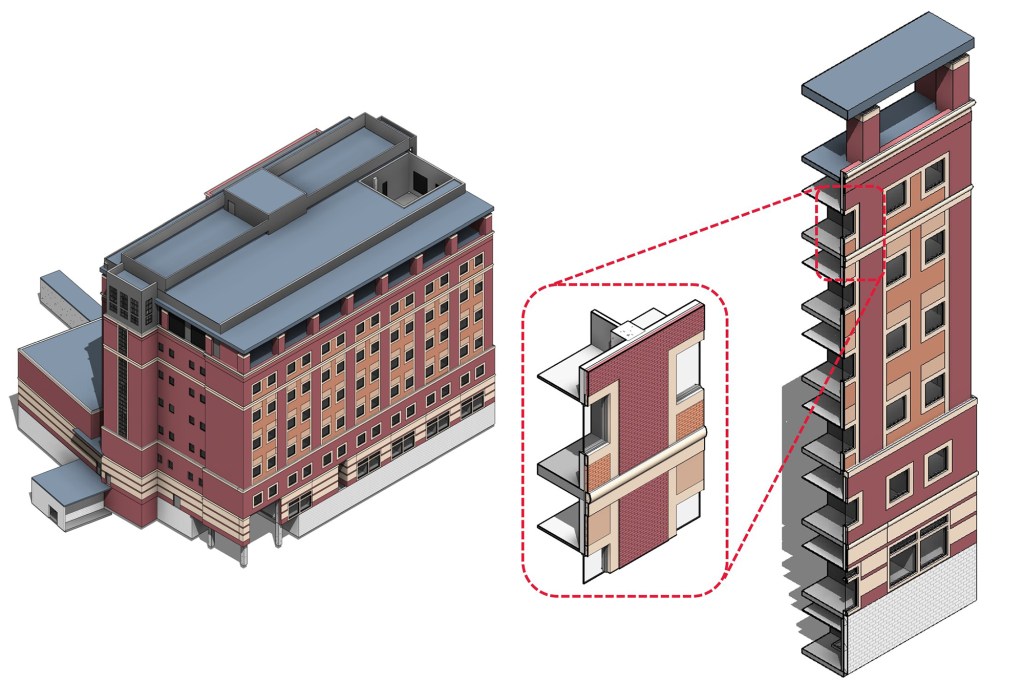Architects are adopting building information modeling (BIM) to streamline their workflows and leverage its tight integration with asset- and space-management software. But the data-rich environment also helps owners make informed decisions and improve facilities management. This is particularly helpful for large organizations that manage multiple facilities and campuses, such as the three entities I describe here. For architects with BIM know-how, supporting their clients’ BIM efforts can lead to a relationship that continues well after project close-out.
The Ohio State University
Based in Columbus, Ohio, The Ohio State University (OSU) has
modeled more than half of its campus, or approximately 17 million square feet,
in Autodesk
Revit. Joe Porostosky, director of OSU’s Facilities Information and
Technology Services (FITS), says that the university initially intended only to
modernize its building documentation, but then realized it could also leverage
the model for campus planning.
Architects working on new-construction projects for OSU exceeding $4 million are required to submit a BIM deliverable, though Porostosky expects the threshold to drop in the future. The university employs architecture and engineering students to field-verify and model existing buildings during the summer, an investment that Porostosky believes is justified: BIM has been used in everything from supporting campus planning activities to recruiting high-profile faculty, to studying options for donor signage.
Local firm DesignGroup was hired to develop a process for integrating BIM into the university’s existing facilities management framework. Brian Skripac, Assoc. AIA, then DesignGroup’s BIM director and now a vice-president at CannonDesign’s Pittsburgh office, helped Porostosky and his team develop a BIM standards document and conduct outreach meetings to educate design and construction firms on the university’s expectations. The standards describe the desired result without prescribing exact requirements; that is, while they define the deliverables, they leave it up to project teams to develop the means and methods to produce them. The standards, Skripac adds, are intended to be revisited and revised actively.
Like Skripac, architects can leverage their expertise by consulting with clients who
wish to develop their own BIM capabilities. This opens the door to additional revenue
streams and, moreover, gives the architect a seat at the table when clients discuss future capital planning needs.

Courtesy The Ohio State University
OSU's BIM Project Delivery Standard Process Map
Carolinas HealthCare System
Carolinas HeathCare System, a nonprofit hospital network based in Charlotte, N.C., currently manages more than 17 million square feet of medical centers and offices, freestanding emergency rooms, and urgent-care centers across the country. In 2009, the use of BIM helped a new hospital project wrap up four months ahead of schedule and save $2 million in construction costs. In 2012, Carolinas, wanting to see what BIM could do for its facilities and operations, began requiring all new projects to be completed in Revit.
Prior to switching to BIM, Carolinas’ staff had to retrace 2D CAD drawings manually in order to input room information in its space management tool, Archibus—a time-consuming process. Since Revit automatically generates room boundaries from walls in the model, BIM manager Meghan Ruffo, AIA, and her three-member team can now easily link building information from Revit into Archibus without additional steps.
Architecture and engineering firms contracted by Carolinas are required to submit a BIM execution plan that outlines how they will utilize BIM throughout a project. Ruffo and her team review the plan and also check submitted models at each project phase to confirm the use of the OmniClass Construction Classification System to identify building elements, and the inclusion of the correct, owner-supplied content in the model, among other criteria. They then score the model based on how well it matches Carolinas’ BIM standards. Models receiving a low score must be reformatted and resubmitted. All of this oversight ensures there are no surprises when the final models are delivered at the end of the project. Once a model has passed the test, Carolinas deploys it into its space-planning and asset-management systems.
By considering how the model will be used beyond the construction document phase,
architects can help BIM-knowledgeable clients better integrate their facilities
data. In this capacity, the architect becomes a partner in achieving the
client’s long-term facility goals rather than just a design-services provider.
Meijer
For
the past 30 years, Grand Rapids, Mich.–based retailer Meijer has been developing a system of
what it calls “smart drawings” that allows employees to design and purchase
equipment for its facilities quickly. With more than 230 stores across six
states, the company continues to expand throughout the Midwest, building 10 new
stores and renovating 10 existing facilities each year.
The company’s CAD administrator Don Ladner says that the key to the system’s success is the assignment of a unique identification number for each piece of equipment and fixture purchased and installed in a facility, regardless of similar product colors or options. This method tells Meijer exactly what equipment is used in every store and how much each item costs.
While many BIM systems track all of an object’s properties in the model file, Meijer simply stores the object’s unique ID. Additional data is accessed from other sources, using the item’s number as a key. For example, a Meijer designer can digitally query a refrigerator object from a particular store and then access external databases to see original pricing data and other stores in which it was installed. This simple setup has allowed the system to adapt over the years.
Though Meijer hires outside design firms to develop its shells and exteriors, its store planning and purchasing processes are carried out internally and are highly automated. Because of the tight integration of data between internal departments, Meijer’s in-house designers have up-to-date pricing available when planning new stores. Once a layout is complete, the designer presses a button and the equipment is automatically purchased, without the need for approvals from the procurement department. In 2014, Meijer’s 16-person design department purchased more than 530,000 pieces of equipment and built or renovated more than 3 million square feet of store space.
For now, the highly automated system does not have a straightforward backend. “One of the biggest lies in the world is ‘off-the-shelf’ software,” Ladner says. Though Meijer makes extensive use of Bentley Systems MicroStation, he estimates that his company uses more than 280 custom programs to fully integrate the various systems. One custom program, which links Meijer’s MicroStation model with its store-planning software Intactix Knowledge Base (now JDA Category Knowledge Base) allows the retailer’s designers to track all of its fixtures, shelving, and signage accurately and in 3D.
Though
Meijer benefits from a highly standardized in-house design process, architects
can learn from the retailer. For example, while most firms maintain
standard detail libraries, few of those libraries also track performance and
cost data. As Meijer has shown, this data is of significant value in the design
process.
With
the increasing adoption of BIM by retail and institutional clients, architects
will likely one day be contractually required to provide some form of BIM
deliverable on projects. They may also be expected to work with their clients’
internal BIM management teams to ensure their digital process and deliverables fit
in their clients’ overall BIM framework. While this move toward BIM on the
client side imposes additional requirements for architects, it also presents new
business opportunities.
For clients who cannot or do not want to support their own internal BIM team, architects can provide this expertise as an additional service, which, as mentioned, has the added benefit of staying in regular contact with the client and their facility needs. Pawtucket, R.I.–based LLB Architects, for example, offers a facilities assessment service for its clients, which are mostly in education. Using BIM, the firm develops a preliminary campus model campus and then analyzes the resulting data to help its client make better decisions about future projects.
As all
stakeholders in the project lifecycle realize the value of BIM, architects will
need to stay current on advances in the technology to stay competitive and
demonstrate competency. That includes learning how to integrate data across
software platforms. While traditional 2D documents were once seen as a record
of the design process, BIM deliverables can provide tangible benefits to
clients long after project completion.
